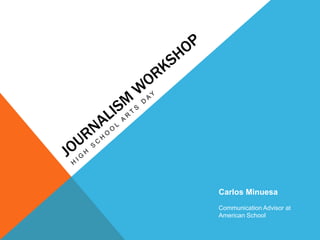Journalism Workshop
- 1. Carlos Minuesa Communication Advisor at American School
- 2. âĒ Journalism : the activity that tells people what is happening around them. âĒ News stories: texts explaining facts of "general interest". âĒ Channels: newspapers, magazines, news on radio and TVs, webs.... WHAT IS JOURNALISM
- 3. Possible codes for news: ï§ Text ï§ Photos / Pictures / Graphics ï§ Audio / Video Language: ï§ Formal but simple writing, easy to understand and read. NEWS LANGUAGES
- 4. These techniques make easier writing stories and make easier to read them. ï§ Use of headlines ï§ The inverted pyramid ï§ The 5 Wâs (Who, What, When, Where, Why) INFORMATIVE TECHNIQUES
- 5. Headlines: short sentences that sum up the news. ï§ Shorter than paragraphs. ï§ Always 1-2 lines, 10-15 words . ï§ Neutral, informative phrase: subject + verb + complements. ï§ Secondary headlines above or below. HEADLINES
- 6. HEADLINES. NEWS AND NEWS REPORTS
- 8. Informative Style. Formal writing but not a novel or an essay. Here are some tips : Use short words, rather than Prefer familiar words over long ones. unfamiliar ones. Use strong verbs. Prefer active Watch use of qualifying words over passive voice. and phrases. Use short sentences. Vary sentence lenght. Be straightforward. Avoid wordiness. Use restraint. Use transitions. Revise. Read your story aloud. INFORMATIVE WRITING
- 9. Photography for journalism has an specific style. ï§ A good shot: not blur, or moved. ï§ The most informative elements inside: the facts, the people. ï§ Preferred, actions than static scenes. Exception: portraits for interviews. PHOTOGRAPHY








